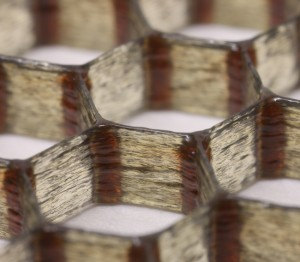Harvard engineers use new resin inks and 3D printing to construct lightweight cellular composites

3D printing has been developed for thermo plastics and UV-curable resins, materials that are not typically considered as engineering solutions for structural applications. But now, Materials scientists at the Harvard School of Engineering and Applied Sciences (SEAS) and the Wyss Institute for Biologically Inspired Engineering have created new 3D resin inks that can used to construct lightweight architectures with 3D printing.
These thermosetting resins are composed of epoxy resins, spiked with viscosity-enhancing nanoclay platelets and a compound called dimethyl methylphosphonate. And then two types of fillers: tiny silicon carbide "whiskers" and discrete carbon fibers are added. Key to the versatility and strength of the resulting fiber-filled inks is the ability to control the direction that the filler ar deposited.
Now, using these fiber-reinforced epoxy-based thermosetting resins and 3D printing, materials scientists have developed cellular composite materials that mimic the structure and performance of balsa wood, with unprecedented light weight and stiffness.
"Balsa wood has a cellular architecture that minimizes its weight since most of the space is empty and only the cell walls carry the load. It therefore has a high specific stiffness and strength," explains Jennifer A. Lewis, the Hansjörg Wyss Professor of Biologically Inspired Engineering at Harvard SEAS. "We've borrowed this design concept and mimicked it in an engineered composite."
Balsa wood is used inside the blades of wind turbines for its light weight and stiffness relative to density. But balsa wood is expensive and natural variations in the grain can be an impediment to achieving the increasingly precise performance requirements of turbine blades.
But the new cellular composites are "as stiff as wood, 10 to 20 times stiffer than commercial 3D-printed polymers, and twice as strong as the best printed polymer composites," the researchers describe their result in the article "3D-Printing of Lightweight Cellular Composites" published in the journal of Advanced Materials co-authored by Lewis and Brett G. Compton, a former postdoctoral fellow in her group.

Left: Optical image of 3D printing of a triangular honeycomb composite. Right: Schematic illustration of the progressive alignment of high-aspect-ratio fillers within the nozzle during composite ink deposition. (Images courtesy of Brett G. Compton, Harvard University.)
"This paper demonstrates, for the first time, 3D printing of honeycombs with fiber-reinforced cell walls," said Lorna Gibson, a professor of materials science and mechanical engineering at the Massachusetts Institute of Technology and one of world's leading experts in cellular composites. "Of particular significance is the way that the fibers can be aligned, through control of the fiber aspect ratio—the length relative to the diameter—and the nozzle diameter. This marks an important step forward in designing engineering materials that mimic wood, long known for its remarkable mechanical properties for its weight."
Left: Optical images of square, hexagonal, and triangular honeycomb structures composed of SiC-filled epoxy. Scale bars are 2 mm. Center and right: Optical images of a triangular honeycomb structure composed of SiC/C-filled epoxy, which reveal clear evidence of highly aligned carbon fibers oriented along the print direction. The scale bars are 500 μm. (Images courtesy of Brett G. Compton, Harvard University.)

The work could not only be used in wind turbines, but also in the automotive industry where lighter materials are needed to help cars to achieve government-mandated fuel economy standards.
Lewis says the next step will be to test the use of thermosetting resins to create different kinds of architectures.
"As we gain additional levels of control in filler alignment and learn how to better integrate that orientation into component design, we can further optimize component design and improve materials efficiency," adds Compton, who is now a staff scientist in additive manufacturing at Oak Ridge National Laboratory. "Eventually, we will be able to use 3D printing technology to change the degree of fiber filler alignment and local composition on the fly." This could lead to advances not only in structural materials, but also in conductive composites.







